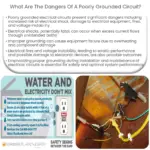Grounded systems provide a safe path for excess current, while ungrounded systems lack this feature, increasing the risk of shock, damage, and fires.
Grounded vs. Ungrounded Electrical Systems
Understanding the differences between grounded and ungrounded electrical systems is crucial for ensuring safety and optimal performance of electrical installations. In this article, we will discuss the key differences between these two types of systems and their implications on safety and efficiency.
1. Basic Definitions
Grounded and ungrounded electrical systems can be defined as follows:
- Grounded System: An electrical system in which the neutral conductor, equipment, or both are intentionally connected to the earth, providing a path for excess current to flow safely.
- Ungrounded System: An electrical system that has no intentional connection between its conductive parts and the earth, resulting in no dedicated path for excess current to flow.
2. Safety and Protection
The most significant difference between grounded and ungrounded systems lies in their safety and protection features:
- Grounded System: Provides an alternative path for excess current, reducing the risk of electrical shock, damage to equipment, and fires. Grounding helps maintain stable voltage levels and protects against lightning strikes.
- Ungrounded System: Lacks a dedicated path for excess current, increasing the risk of electrical shock, equipment damage, and fires. Voltage stability and lightning protection are also compromised.
3. Fault Detection and Isolation
Grounded and ungrounded systems differ in their ability to detect and isolate faults within the electrical system:
- Grounded System: Faults in grounded systems are typically easier to detect, as they often cause protective devices such as circuit breakers or fuses to trip, isolating the fault and preventing further damage.
- Ungrounded System: Faults in ungrounded systems can be difficult to detect, as there may be no immediate indication of a problem. This can result in undetected faults that can cause severe damage over time.
4. Application and Usage
Grounded and ungrounded systems are typically used in different applications:
- Grounded System: Commonly used in residential, commercial, and industrial settings due to its safety features and stable voltage performance.
- Ungrounded System: Sometimes used in specialized applications, such as certain industrial processes, where ground faults might be tolerated for continuity of operations. However, ungrounded systems are becoming less common due to their inherent safety risks.
Conclusion
The primary difference between grounded and ungrounded electrical systems lies in their safety and performance characteristics. Grounded systems provide a safer and more stable environment for electrical installations, while ungrounded systems pose increased risks due to the absence of a dedicated path for excess current. As a result, grounded systems are generally preferred in most applications, ensuring the safety and efficiency of electrical installations.




